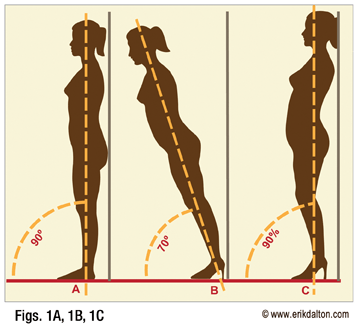Summary: In a highly functioning body, the neuro-myoskeletal system hangs in dynamic equilibrium, with each part balancing the other. But when a woman chooses to wear high heels, a new dynamic equilibrium occurs. If even one body part becomes fixed, the whole system must compensate with altered movement patterns, resulting in kinetic “chain” kinks.
Last week while going through TV channels, I happened to catch some interesting gossip from a cheesy entertainment show reporting that Stefani Germanotta, aka Lady Gaga, was being treated for low-back pain at a local physical therapy clinic. This uniquely talented, five-time Grammy Award winner and self- proclaimed “high heeled queen of sheen” has definitely done more to mess up low backs than anyone since Mike Tyson. So, here she is at the ripe age of 25 suffering back spasm.

Although high heels have been in and out of vogue since Catherine of Medici invented them in Paris in the 16th century, I have always been puzzled by the strange attraction to body height— which figures, since I was always the tall one in class. I had somehow missed the point, so I decided to pose the question to my wife. She told me, “Erik, some women would grow their toenails long and walk on them if they thought it would make them look sexier.”
That answer certainly did not settle my curiosity, so I searched online for some fashion-magazine photos of high-heeled ladies, studied the postures and finally arrived at three seemingly logical visual bonuses gained from wearing high heels. Curvier hips and a more prominent buttock happen due to exaggerated lumbar lordosis, the legs appear longer and leaner as the thoracic spine hyperextends to compensate for the swayed low back, and the female chest becomes more prominent as the shoulder girdle is driven back by the hyperextended thorax.
The biomechanical effect of heels, in everything from running shoes to stilettos, has puzzled researchers and fueled controversy for about a century.
Here is an interesting experiment that will help you get a feel for the biomechanical adjustments high-heel wearers deal with every day:
Stand barefoot with the back against a wall and observe how your upright body column forms a perpendicular line, or 90-degree angle, with the floor. Slide a 2-inch wedge of some kind, such as a phone book, under both heels. Notice by keeping your body column rigid, you are forced to tilt forward from 90 to about 70 degrees.

Now replace it with a 3-inch wedge and straighten up so you are touching the wall again. Feel the intense myoskeletal adaptations that take place. Can you feel your ankles alter from dorsi- to plantar-flexion? In this standing position, the knees buckle, hips flex, low back sways, and the shoulder girdle retracts.
The brain, guided by foot, ankle and visual proprioceptors, must instantaneously make a whole series of myofascial and joint adjustments to the ankle, knee, hip, spine, and head to regain and retain erect stance and equilibrium.

But high-heeled, posturo-functional faults are not limited to the external milieu – they may also inflict compressional damage on the internal viscera, particularly the pelvic bowl contents. According to a report conducted by Canadian physiotherapist Diane Lee, in “Biomechanical Effects of Wearing High Heel Shoes,” published in the International Journal of Industrial Ergonomics, excessive lumbar lordosis causes the pelvic bowl to dip anteriorly, which raises the center of gravity and leads to reduced proprioceptive stability. So not only are we unstable on our feet when wearing heels, but the dramatic anterior pelvic tilt squashes our poor organs.
For instance, when standing barefoot, the anterior angle, or pelvic tilt, of the female pelvis is 25 degrees. On 1-inch heels it moves up to 30 degrees, on 2-inch heels it increases to 45 degrees, and on 3-inch heels it increases up to 60 degrees…
Read more at
http://erikdalton.com/media/published-articles/gaga-over-heels/
Erik Dalton, Ph.D., Certified Advanced Rolfer, started the Freedom From Pain Institute and created Myoskeletal Alignment Techniques to share his passion for massage, Rolfing, and manipulative osteopathy. Visit the Erik Dalton website for information on workshops, conferences, and CE home study courses.
On sale this week only!
Save 25% off the "Dalton Technique Treasures" eCourse
The “Dalton Technique Treasures” eLearning course is a compilation of some of Erik’s favorite Myoskeletal Alignment Techniques (MAT). Learn MAT techniques to assess and address specific sports injuries, structural misalignment, nervous system overload, and overuse conditions. ON SALE UNTIL July 29th! Get Lifetime Access: As in all our eLearning courses, you get easy access to the course online and there is no expiry date.






